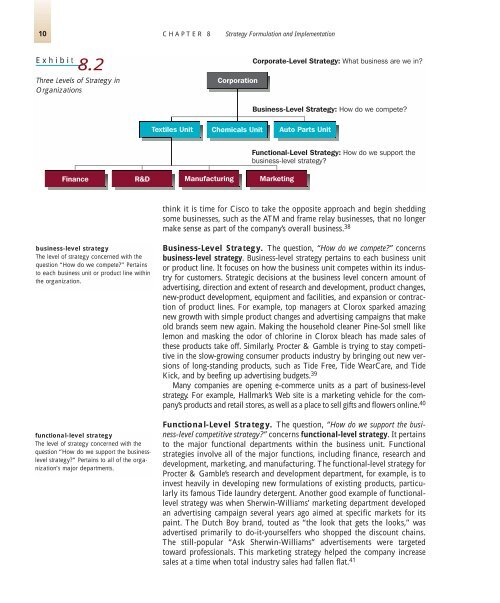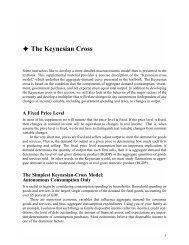chapter 8: strategy formulation and implementation
chapter 8: strategy formulation and implementation
chapter 8: strategy formulation and implementation
Create successful ePaper yourself
Turn your PDF publications into a flip-book with our unique Google optimized e-Paper software.
10 CHAPTER 8 Strategy Formulation <strong>and</strong> Implementation<br />
Exhibit<br />
8.2<br />
Three Levels of Strategy in<br />
Organizations<br />
business-level <strong>strategy</strong><br />
The level of <strong>strategy</strong> concerned with the<br />
question “How do we compete?” Pertains<br />
to each business unit or product line within<br />
the organization.<br />
functional-level <strong>strategy</strong><br />
The level of <strong>strategy</strong> concerned with the<br />
question “How do we support the businesslevel<br />
<strong>strategy</strong>?” Pertains to all of the organization’s<br />
major departments.<br />
think it is time for Cisco to take the opposite approach <strong>and</strong> begin shedding<br />
some businesses, such as the ATM <strong>and</strong> frame relay businesses, that no longer<br />
make sense as part of the company’s overall business. 38<br />
Business-Level Strategy. The question, “How do we compete?” concerns<br />
business-level <strong>strategy</strong>. Business-level <strong>strategy</strong> pertains to each business unit<br />
or product line. It focuses on how the business unit competes within its industry<br />
for customers. Strategic decisions at the business level concern amount of<br />
advertising, direction <strong>and</strong> extent of research <strong>and</strong> development, product changes,<br />
new-product development, equipment <strong>and</strong> facilities, <strong>and</strong> expansion or contraction<br />
of product lines. For example, top managers at Clorox sparked amazing<br />
new growth with simple product changes <strong>and</strong> advertising campaigns that make<br />
old br<strong>and</strong>s seem new again. Making the household cleaner Pine-Sol smell like<br />
lemon <strong>and</strong> masking the odor of chlorine in Clorox bleach has made sales of<br />
these products take off. Similarly, Procter & Gamble is trying to stay competitive<br />
in the slow-growing consumer products industry by bringing out new versions<br />
of long-st<strong>and</strong>ing products, such as Tide Free, Tide WearCare, <strong>and</strong> Tide<br />
Kick, <strong>and</strong> by beefing up advertising budgets. 39<br />
Many companies are opening e-commerce units as a part of business-level<br />
<strong>strategy</strong>. For example, Hallmark’s Web site is a marketing vehicle for the company’s<br />
products <strong>and</strong> retail stores, as well as a place to sell gifts <strong>and</strong> flowers online. 40<br />
Functional-Level Strategy. The question, “How do we support the business-level<br />
competitive <strong>strategy</strong>?” concerns functional-level <strong>strategy</strong>. It pertains<br />
to the major functional departments within the business unit. Functional<br />
strategies involve all of the major functions, including finance, research <strong>and</strong><br />
development, marketing, <strong>and</strong> manufacturing. The functional-level <strong>strategy</strong> for<br />
Procter & Gamble’s research <strong>and</strong> development department, for example, is to<br />
invest heavily in developing new <strong>formulation</strong>s of existing products, particularly<br />
its famous Tide laundry detergent. Another good example of functionallevel<br />
<strong>strategy</strong> was when Sherwin-Williams’ marketing department developed<br />
an advertising campaign several years ago aimed at specific markets for its<br />
paint. The Dutch Boy br<strong>and</strong>, touted as “the look that gets the looks,” was<br />
advertised primarily to do-it-yourselfers who shopped the discount chains.<br />
The still-popular “Ask Sherwin-Williams” advertisements were targeted<br />
toward professionals. This marketing <strong>strategy</strong> helped the company increase<br />
sales at a time when total industry sales had fallen flat. 41










